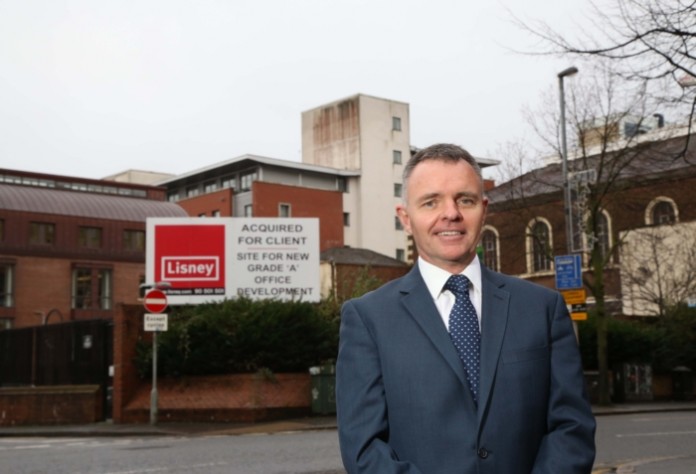Retail property saw another year of improvement in 2016 as prime vacancy in Belfast dropped to its lowest level in over a decade, with the city going from having one in five shops vacant in 2014 to one in 10 shops vacant last year.
Leading commercial property agent Lisney has insisted the “fundamentals of the local commercial property market remained strong across all sectors” and that the market is on a “solid footing” going forward, despite investment levels having dropped by almost 50% in 2016 – from 2015’s five-year high of £420m to £213m – amidst ongoing political uncertainty.
Launching its 2016 Northern Ireland Commercial Property Report – the most comprehensive and long-established study of the commercial property market in Northern Ireland across the investment, retail, office and industrial sectors – Lisney revealed investment volumes of £40m for the final quarter of 2016.
While office take-up more than doubled and owner occupiers continued their dominance in the industrial sector, uncertainty throughout 2016 hampered the investment market in Q4, as in the previous quarter.
Key findings of the report included:
- Investment volumes dipped almost 50% in 2016, from 2015’s five-year high of £420m to £213m
- Office take-up more than doubled in 2016 to a five-year high of 535,000 sq ft, and rents rose by an unexpected 25%
- The retail sector expanded at its fastest rate since 2002, with prime vacancy dropping to 10.5% in 2016 – the lowest level since Lisney started doing its Retail Vacancy Survey in 2011
- Prime Belfast city centre retail rents are now trending at £125 per sq ft (Zone A)
- Industrial vacancy rates dropped by 25% in 2016 on the previous year, with an increase in take-up of 12.5% in the same period
Launching the report, Declan Flynn, Managing Director of Lisney Northern Ireland, said:
“Investment volumes of £40m for the final quarter of 2016 go some way towards demonstrating the prevailing challenges currently facing the investment sector, such as the triggering of Article 50, the local political situation and the potentially more protectionist agenda coming out of the US.
“However, despite the political uncertainty, the market has remained relatively robust in a number of areas. We have seen the return of the UK pension funds to the province, acquiring the DSG investment at Sprucefield, which is a welcome sign that they are comfortable with the longer-term sustainability and resilience of our market.
“Uncertainty at a local and national level will continue to stall investment decisions, but our fundamentals remain strong in all sectors. The market is on a solid footing and, with low interest rates, commercial property remains an attractive proposition.
“As expected, we saw another year of improvement across the retail sector. Prime vacancy in Belfast dropped to its lowest level since we started our research, with the city going from having one in five shops vacant in 2014 to one in 10 shops vacant last year.
“These falling vacancy rates have placed upwards pressure on rents, with prime city centre pitches now trending at £125 per sq ft (Zone A), while the overall retail story has been further buoyed by a devalued pound, encouraging shoppers from the Republic to venture north.
“The retail outlook for 2017 is positive, with continued demand for prime space and a number of new retail developments, such as Turkington’s Laganbank scheme in Lisburn and Parker Green’s extension to the Quays in Newry, coming on stream. Prime rents look set to continue rising, with vacancy rates continuing to reduce.”
Amongst the most significant commercial property transactions during the final quarter of 2016 was the purchase of Lisnagelvin Shopping Centre by Cordatus Property Trust on behalf of CBRE Global Investment Partners for £14.73m, and the purchase of the DSG investment at Sprucefield by Aberdeen Asset Management.
Although take-up of office space throughout 2016 was constrained by a lack of high quality stock, quarter four of 2016 reached more encouraging levels of 225,000 sq ft, bringing the total for the year to 535,000 sq ft. Notably, almost half of the space taken up within the quarter relates to the redeveloped Clarendon House, in which Belfast City Council will occupy 100,000 sq ft.
Commenting on the office market and industrial sector, Declan continued:
“The prospect of office development continues to strengthen, with planning consent recently renewed on the Orby Developments-owned site on Belfast’s Chichester Street, which has the potential to offer 100,000 sq ft office space, with other planning approvals including Kilmona’s East Bridge Street and McAleer & Rushe’s Bedford Square.
“Although this is positive news, delivery timescales are likely to run from 2018 onwards, so refurbishment schemes are likely to plug the short-term supply gap.
“In the industrial sector, lack of supply, particularly for larger space over 50,000 sq ft, remains a concern. In certain areas, owner occupiers are paying a premium for suitable space as the demand is outstripping the supply.
“Demand for space less than 20,000 sq ft remains strong, however design and build projects will become increasingly central in meeting the requirements of larger occupiers and specific requirements.
“There are a number of active occupiers who have various specific requirements and they are now looking at design and build options. A potential headache also looms in the form of the measures proposed in the ‘Rates Rethink’ document which has been issued for consultation by the Department of Finance.”



















